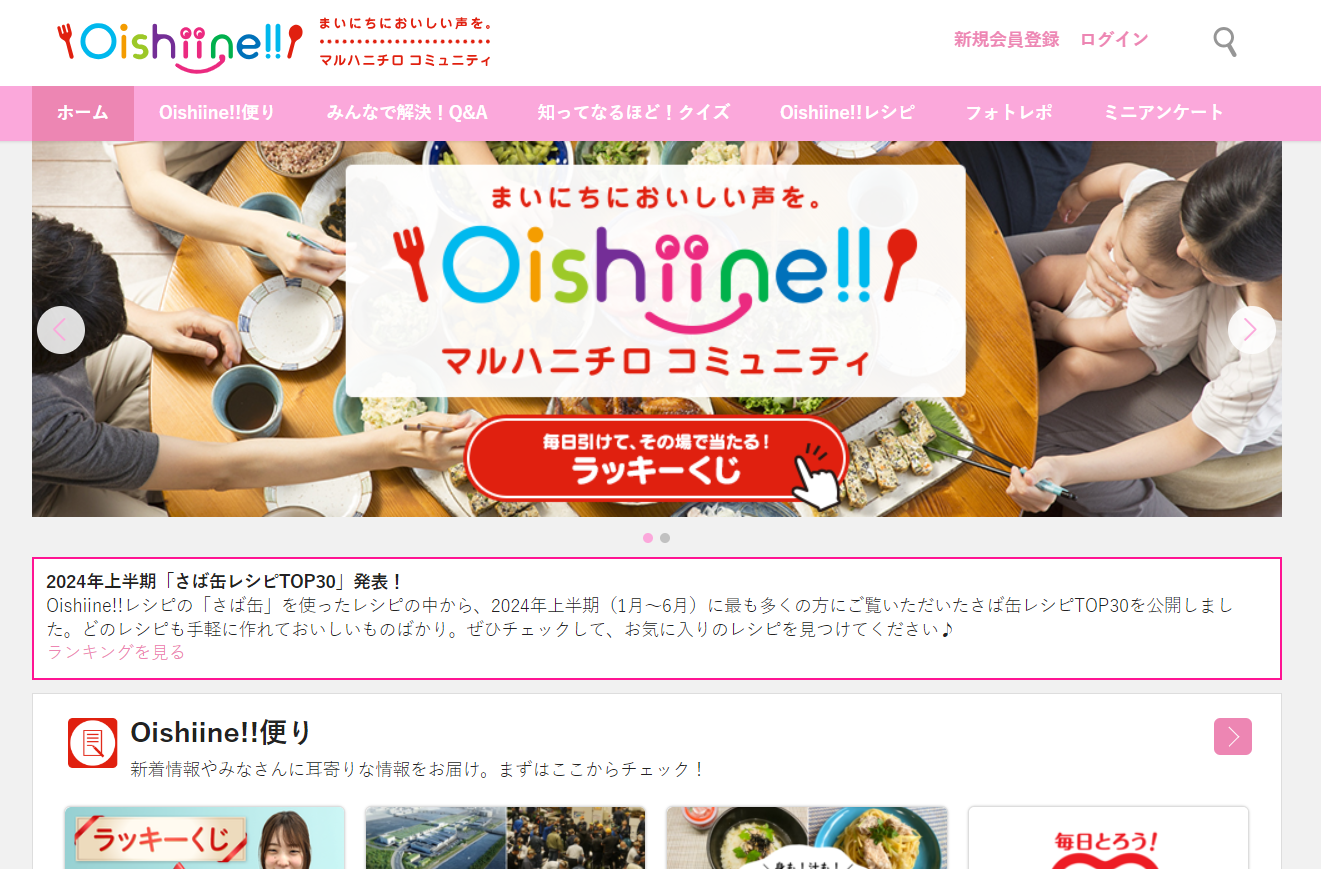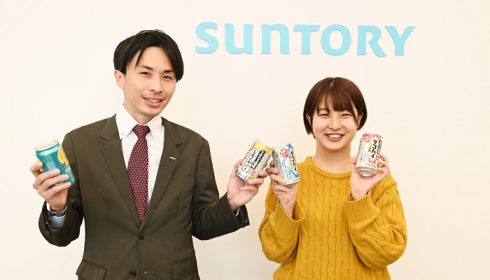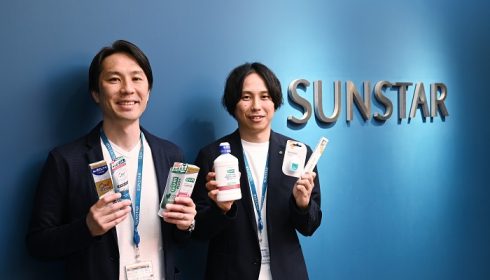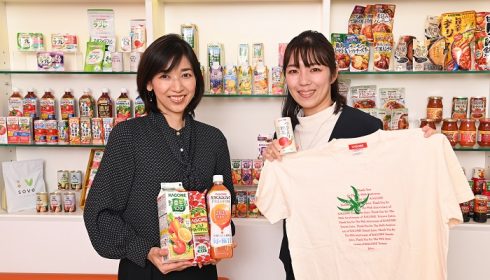What the Maruha Nichiro "Oishiine!!" community can do in the balance between economic value and social value
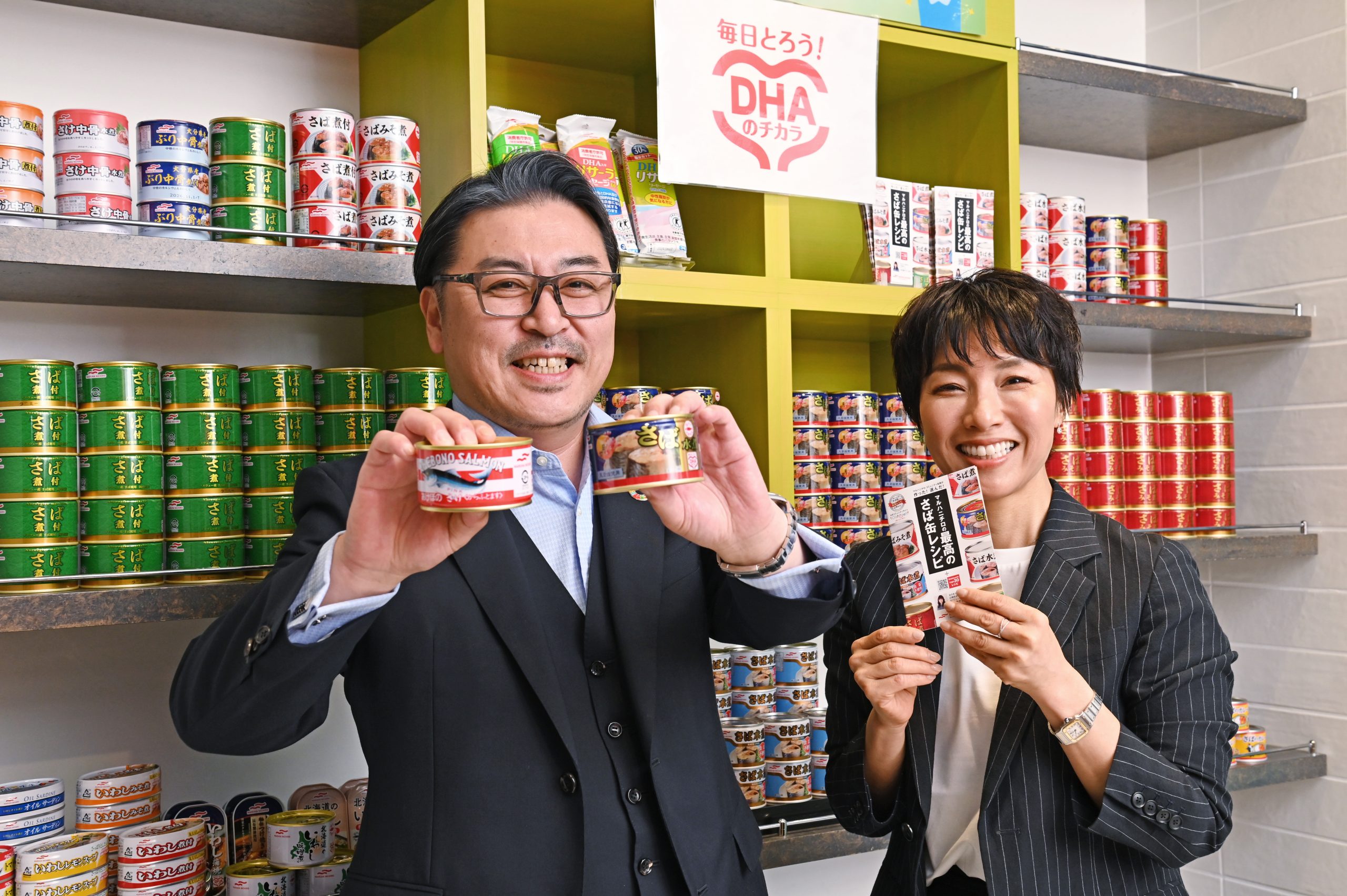
Fan marketing, D2C, and other terms vary, but more and more companies are now trying to connect directly with their customers. In this series of interviews with partner companies that practice partner relationship management (PRM), including communities, we will clarify "why direct connection is necessary" and "what companies need to change accordingly. The interviewer is Tatsuo Ishii, Executive Advisor of Kao Corporation, who has long been involved in brand marketing at Kao Corporation.
"Oishiine!!" is a long-established community operated by Maruha Nichiro, a leading food company. Counting from its predecessor, "Smart Bishoku CLUB," it has continued to play an important role in connecting the company with its customers for over 10 years.
The number of members and viewers has increased rapidly from last year to this year due to the popularity of content related to the company's signature product, canned mackerel. The company has seen further growth here. As times change, the values that companies should pursue also change. How should the community change accordingly? What is the essence of a community that still remains the same? We interviewed Mr. Koji Owada, the company's Marketing Department Manager, and Ms. Tomoko Noguchi, the Marketing Section Manager of the same department.
- Communication should be two-way by nature. Maruha Nichiro's basic stance, which is not limited to the community, is to listen to the voice of the customer and not just send out one-way messages.
- Social value is also important today, but it is ultimately the customer who decides what is considered valuable. Communities can be a valuable tool for mutual understanding.
- Social value can be linked to economic value depending on how it is done. While maintaining the concept of "eating well," from now on we will also communicate issues of health and resource management.
--I understand that "Oishiine! is celebrating its 10th anniversary and we have heard that the number of visitors and members to the site has increased rapidly. I understand that content related to your signature product, canned mackerel, is particularly popular.
【Owada】 With the help of the person in charge of eLife, we focused on site analysis. From what perspective do we create articles and how do we communicate with customers? I think the result of facing each of these issues one by one and reflecting them in the content was the result. As you said, Saba has become a killer content.
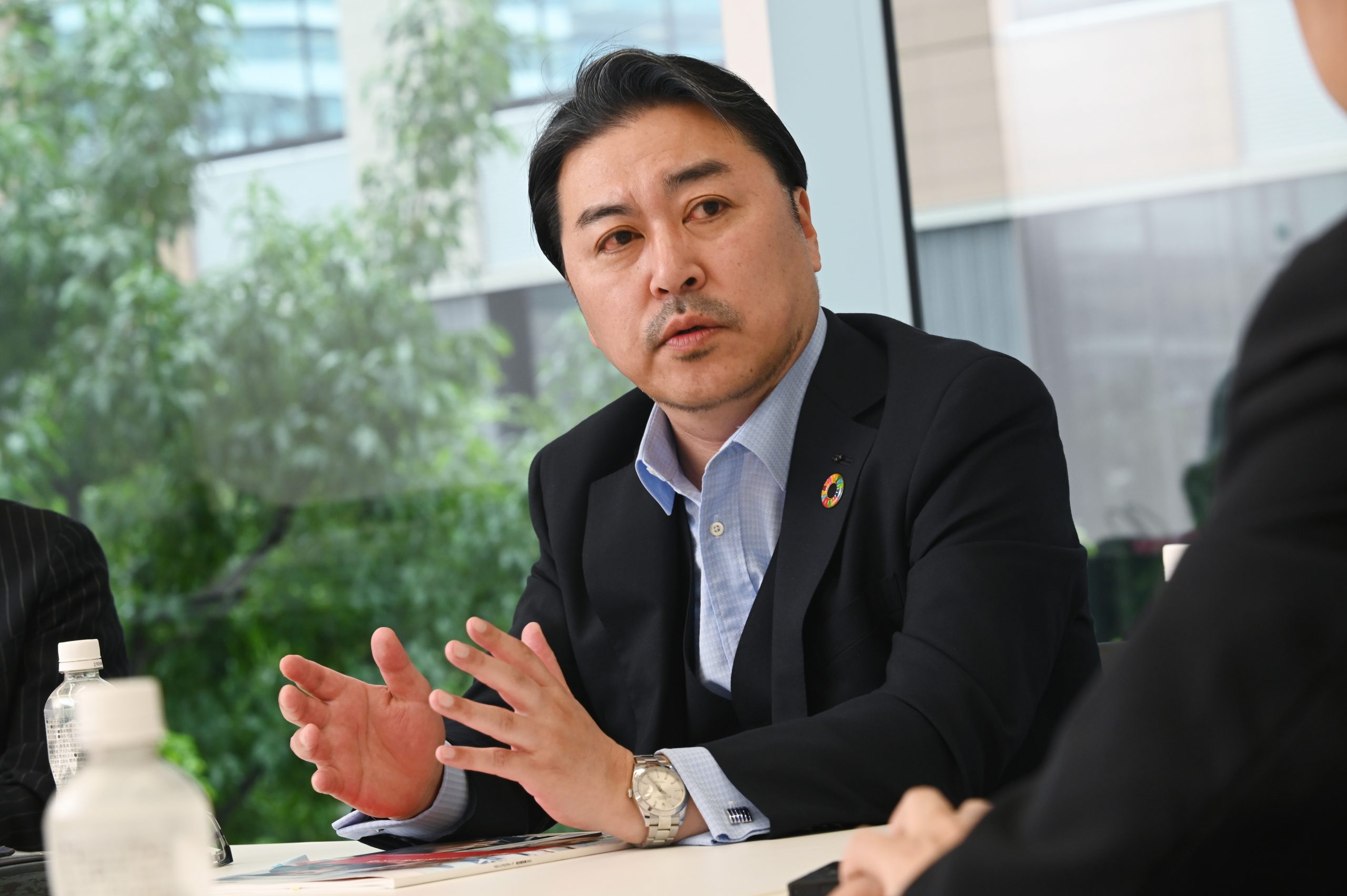
Maruha Nichiro Corporation Mr. Koji Owada, General Manager, Marketing Dept.
【Noguchi】 Ms. Yoko Ikeda, who is in charge of public relations for the All Japan Mackerel Federation, has been very active in the field of canned mackerel. The recipes she has developed and supervised have been very well received. When we, as manufacturers, try to communicate about our products, we tend to put a lot of effort into it and become overly self-centered. We are very grateful to have someone like Ms. Sabagene, who is well versed in the qualities of mackerel, speak for us from an objective standpoint.
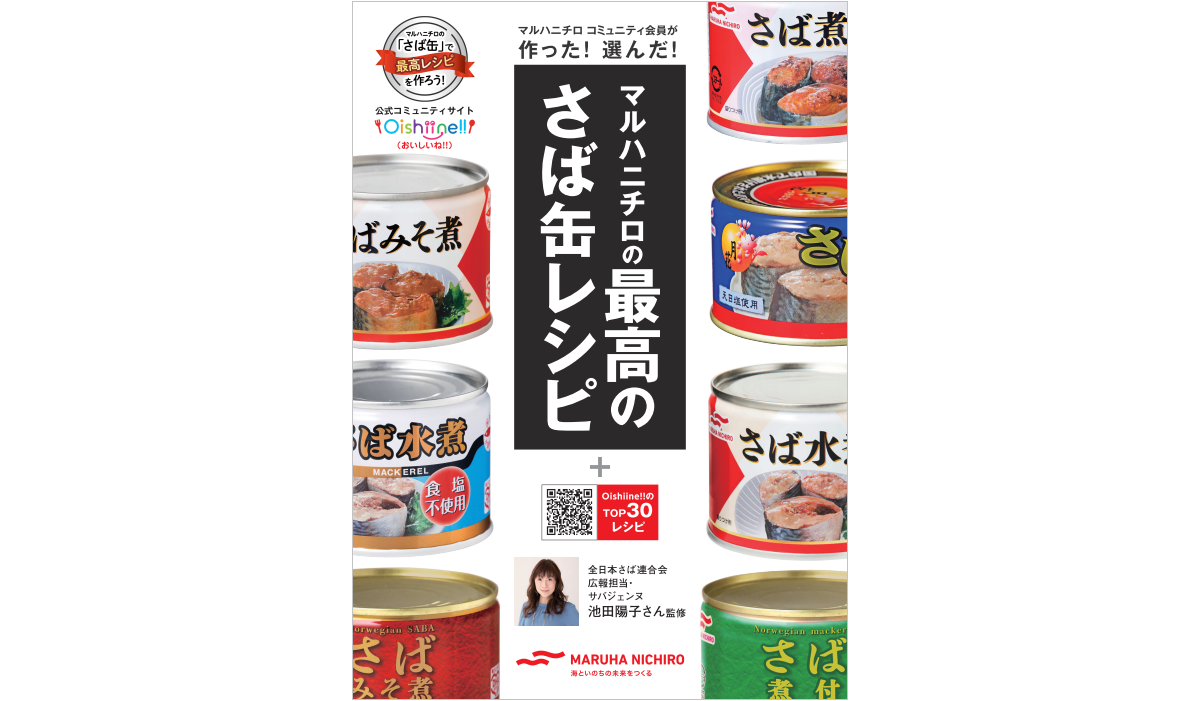
Under the supervision of Yoko Ikeda, a recipe book was created with a collection of recipes devised by members. The book is used for exhibitions, events, and sales activities.
--Nowadays, it is not a time when all you have to do is run TV ads and everything is ok. No matter how many advertisements are placed, if word of mouth is negative, customers will not buy the product. On the other hand, if the word of mouth is positive, some products can be sold without advertisements. I feel that customers' comments have the same or even more power than corporate advertisements.
【Owada】 "Facing the voices of our customers" is a basic stance of our company that is not limited to the community. The Development Department, the Customer Service Center, the Central Research Laboratory, and our Marketing Department have established a cross-departmental Product Improvement Study Group. Although it is very analog, we also listen together to recordings of "voices" received at the Customer Service Center. Based on customer comments such as "difficult to use," "difficult to read," and "difficult to understand how to cook," we prioritize them and propose improvements to each department.
We also hold regular meetings, with board members in attendance, to share the progress of improvements. We are always surprised by the fresh ideas of our customers, and we receive very valuable suggestions and opinions from them.
--In other words, that’s a comment made with love, right?
【Owada】 That's right. The fact that they call us all the way is an indication of their expectations of us. If we can make improvements to meet those expectations, we can create new value. We have declared and are promoting consumer-oriented management, and I believe that the essence of this lies in co-creating value with our customers.
Maruha Nichiro has its roots in being a fishery company. There was a time when Maruha Nichiro was known as "The World's Fishmonger. Fish are slow and easily damaged. How to ensure that customers buy fish with peace of mind and enjoy its taste depends on a relationship of trust. I think that starts with listening to customers' opinions.
We often clash with the main department, but we patiently discuss and try to find a compromise.
--Speaking of fishmongers, I often say at Waseda Business School, where I also teach, "Digital marketing today is just like what fishmongers used to do. In those days, there were no refrigerators, so fishmongers wanted to sell all the fish they bought at the fish market by the end of the day. Of course, at the highest price possible. To do this, he would sell fish along with cooking methods, keeping in mind what kind of fish his customers liked, what kind of cooking they liked, and what their menu was like the day before. This is the very essence of today's digital marketing, which optimizes communication based on purchasing history and hobbies. In other words, I am saying that this is not something new, but the conservative mainstream of marketing.
【Owada】 We have a similar story. In the old days, fishmongers would always provide information when selling their products, such as, "Fresh sardines are in today," or "It tastes good this time of year when it is boiled in ume (plum paste). Conversely, customers would ask, "What ingredients are good for sashimi?" I would sometimes suggest a set of ingredients, including how to eat them. In other words, there was two-way communication.
Nowadays, the consumption of fish in Japan has greatly decreased, and I believe that one of the reasons for this is the disappearance of this kind of communication. In customer surveys, there are a great many people who say they do not know how to handle or eat fish. Conversely, supermarkets specializing in fresh fish that provide information on how to eat and process fish are still very popular.
--In the past, marketing communication was a one-way transmission of information from the company. However, communication, by its very nature, requires a two-way exchange. It is important to be able to catch up with customers in a step-by-step manner. And I think communities are very well suited for this.
【Owada】 Supermarkets have long had a "52-week proposal," in which the year is divided into 52 weeks and sales promotions are made according to that season or event. But nowadays, we don't live in an era of "everyone goes cherry blossom viewing when the cherry blossoms bloom" or "everyone eats eel on Doyou-no-Ushi (the day of the ox). We have a much more diverse diet.
That is why we need to be more attentive to individual lifestyles. We manufacturers tend to "send out information and that's it," but as you say, we need to take a more in-depth look.
-- In "Oishiine!!", the content titled "Introduction to Maruha Nichiro's Work" started in 2022, didn’t it?
【Owada】Our annual sales are 1 trillion yen, of which only 100 billion yen is actually from B-to-C sales, which are the direct contact with consumers. Of course, products are the biggest touchpoint, but in order for people to know what Maruha Nichiro values and what the company does, we need a boost from the media.
That's why we started a content called "Maruha Nichiro's Job Introduction". For exampleCooking live online connecting customers with a kampachi fish farm on Amami Oshima IslandThe Also,Showing footage of fishing boats catching pollack in the Bering Sea in Alaska, andThe ship is a very powerful and impressive image that will make you feel seasick just by looking at it. Many people were surprised by the powerful images that made them feel seasick just looking at them, and by the fact that there was a factory inside the ship! and "I can't believe there's a factory inside the ship! Thanks to all of you, we have received quite a positive response.
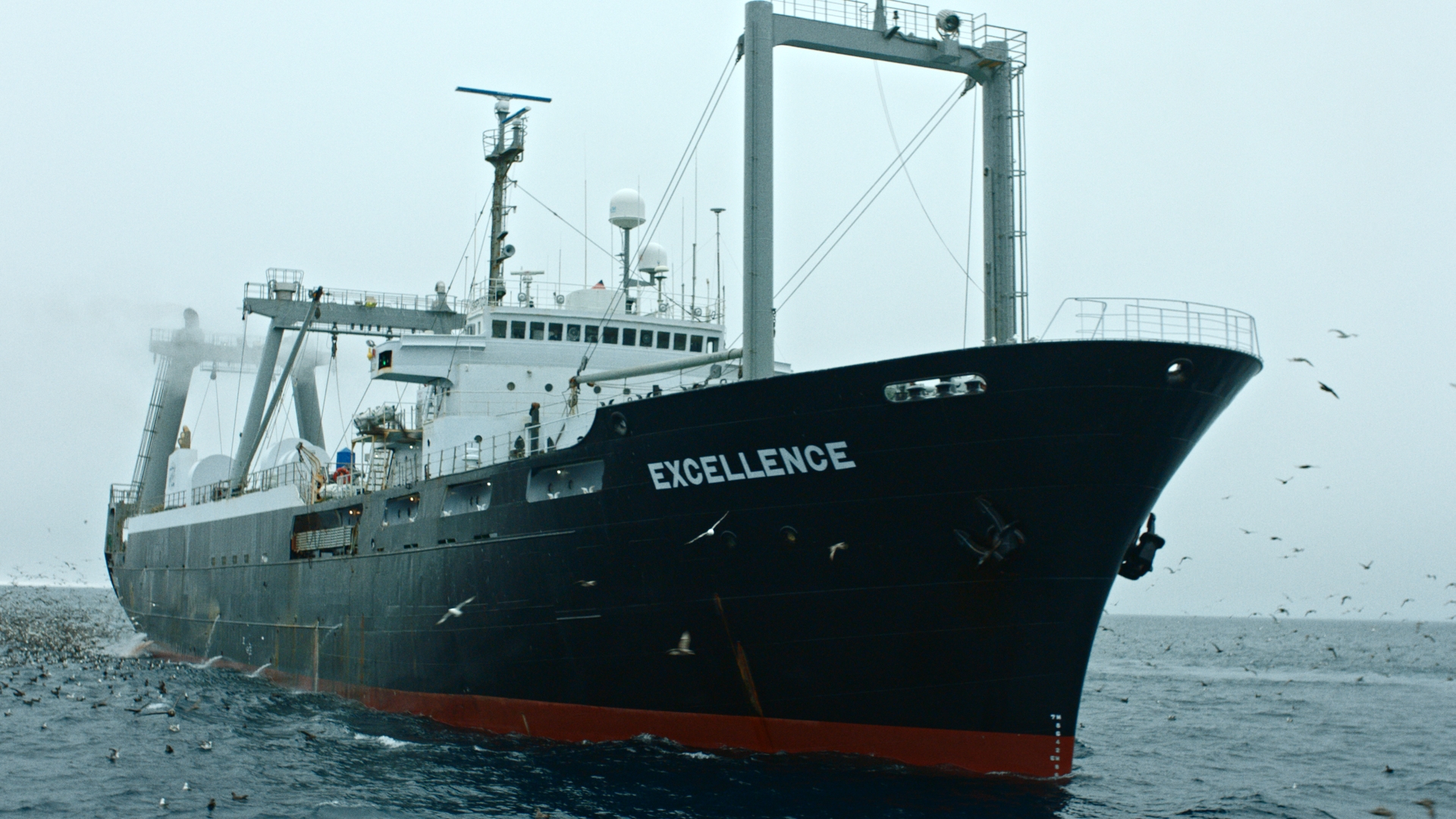
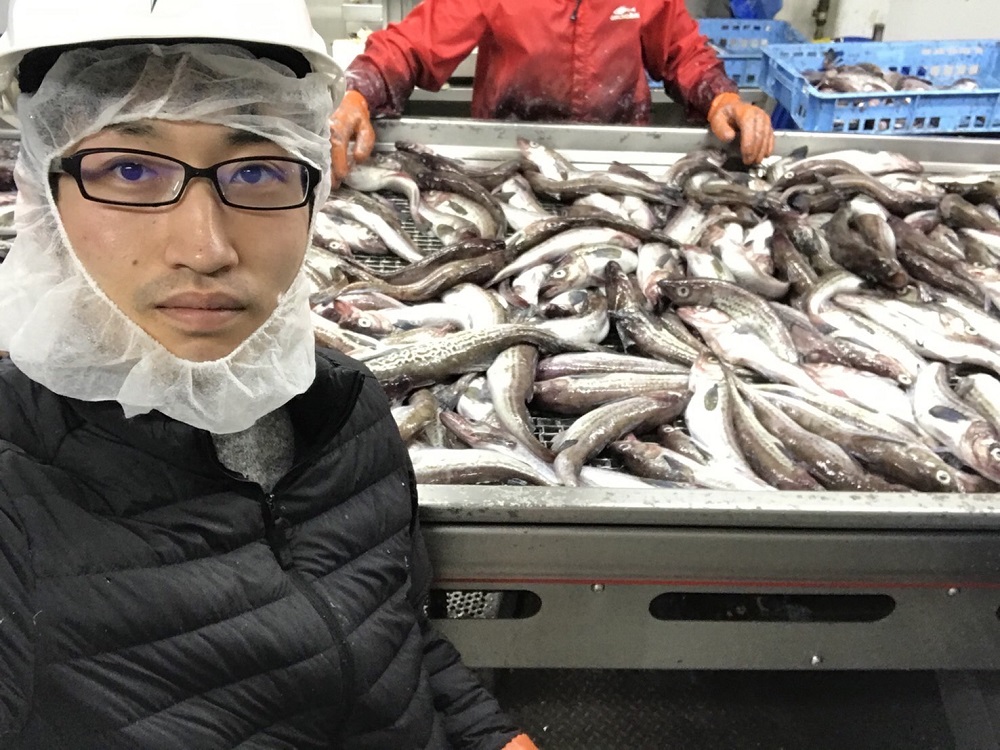
When we sent out a message about how surimi is processed on board a ship in the Bering Sea, we received the following message: "I was surprised that there is a factory on board. I was surprised to find a factory on board. It must be delicious because it is processed fresh! The response was, "It's so delicious because it's processed while it's still fresh!
--I guess it is natural for the company, but for the customer, it must be a fresh surprise.
【Noguchi】 Visible products tend to be commoditized, and it is products that are mass-produced in factories that need to be actively shown behind the scenes. If we do not do so, it will be difficult for our ideas to reach our customers.
Not only the main department, but also the development, factory, logistics, and sales departments are all supporters of our products. We all work together to deliver our products to our customers. Through these contents, we would like to convey the thoughts and passion of the people involved.
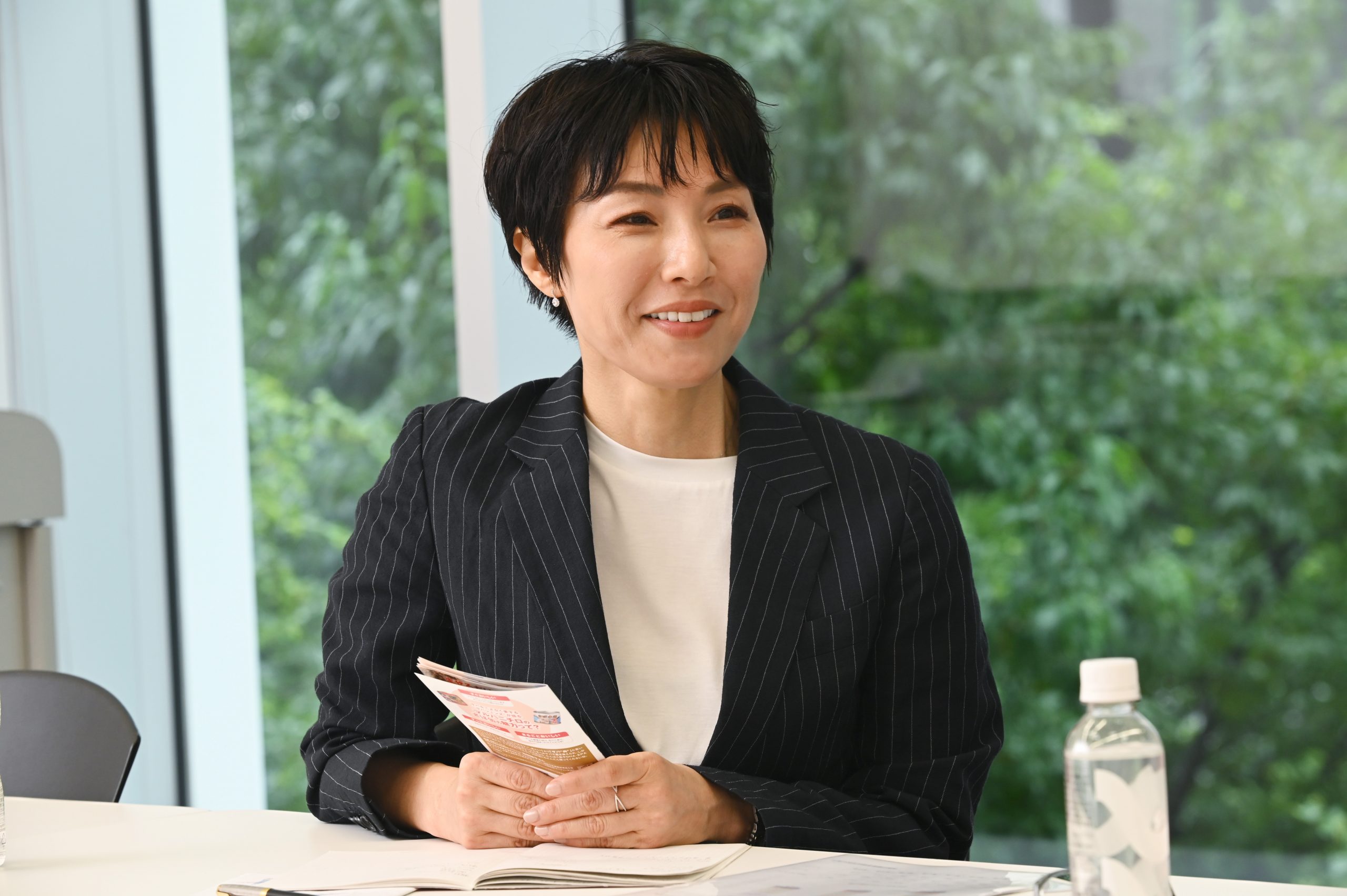
Maruha Nichiro Corporation Tomoko Noguchi, Marketing Section Manager, Marketing Department
【Owada】 This is one of the reasons we started the 'Introduction to Maruha Nichiro's Work' content. The truth is, there are still many employees within the company who are not aware of "Oishiine!!". So, by engaging our employees through this content, we hope to increase the number of people who think "Oishiine!!" is great. After all, if we don’t, our customers won’t think it’s great either. That’s why we intentionally prioritize featuring colleagues who work at fish farms and factories far from headquarters. When we do, they’re often quite happy and say, 'You're going to interview us!?'. They speak passionately about their work.
Recently, this circle has gradually expanded, and departments such as the canning business are actively cooperating with us, we are sometimes asked for advice on what we want to communicate to consumers. If we were to come up with content on our own, we would get stuck in a rut, but we sometimes receive information and ideas that are beyond our imagination.
--It is important. In creating a corporate brand, everyone who works for Maruha Nichiro must understand and embody the Purpose. But it is not just the president's speech that makes this happen. The attitude of each and every employee changes when they see that "customers love Maruha Nichiro so much," or "people in other departments are making products with such thoughts in mind. I thought that through the community, we are truly working to create a corporate brand.
【Owada】 Our associates work all over the world. We would like to spotlight these people even a few times a year, not only to introduce their products and recipes but also to tell them how difficult it is to catch fish and the need to protect resources.
--Do you think the social environment surrounding companies and customer awareness has changed over the past 10 years and the content of what should be communicated in the community has also changed in response?
【Owada】 Companies are becoming increasingly aware of social and environmental values in addition to economic values. Then, what is this value that you are referring to? That is for customers to decide, not for companies to impose unilaterally. Therefore, it is necessary to know how customers are responding to what we are sending out. I believe that a community website is an important tool for matching the scale and the perspective.
Our activities with an awareness of social and environmental values are not simply to attract ESG investment. We must do so in a sustainable manner for the benefit of our customers. We want our customers to know that, and we also want to know how they feel about it. In this way, I would like to make this a tool for mutual understanding.
--What kind of social value do you intend to transmit?
【Owada】 One is health. Food and health are inseparable. We are trying to build health-related content for the next fiscal year. However, the hurdles are high. For example, there are legal issues such as the Health Promotion Law and the Pharmaceutical Affairs Law. We cannot make direct statements such as, "This product is good for neutral fat. We are discussing with the person in charge of eLife what kind of construction we should do.
What kind of nutritional improvement should Maruha Nichiro work on? The first and foremost is "reducing salt. Too much salt is considered the worst thing nutritionally speaking. The average Japanese person consumes about 10 g of salt per day, but the MHLW's standard is 7 g. We need to think about how we can contribute to reducing this 3 g. As a food developer, it is a difficult task. Salt is the cheapest and most important seasoning, and it has a great impact on taste. However, we consider this to be a major social issue, and we intend to make it a KPI to be addressed on a company-wide basis.
--It is important to be able to transmit the information in a way that is consistent with the concept of "Oishiine!!".
【Owada】 Well-being is a popular term nowadays, but this term includes not only physical health, but also emotional aspects. For example, if we forcibly separate good taste from food for the sake of health, wellbeing will not be realized. It may be that there is an image that "less salt = less tasty," and it is true that when you put out the word "less salt," things tend to not sell well. However, a certain supermarket experimented with selling prepared foods without announcing to customers that they were low-sodium prepared foods. As a result, none of the customers noticed the reduced-sodium content.
In fact, we have achieved salt reduction with canned foods. Canned food is a good source of protein and contains high levels of omega-3 fatty acids such as DHA. We have expanded our product lineup to allow customers to choose canned foods with or without salt to suit their cooking, health, and personal preferences.
Furthermore, the recycling rate of cans is over 90%. Canned foods that can be distributed and stored at room temperature are also good for the environment.
While maintaining the value of "deliciousness," we are determined to promote the possibilities of canned foods. In fact, canned foods have a long history, dating back to the time of Napoleon, and we believe that canned foods are the food of the future.
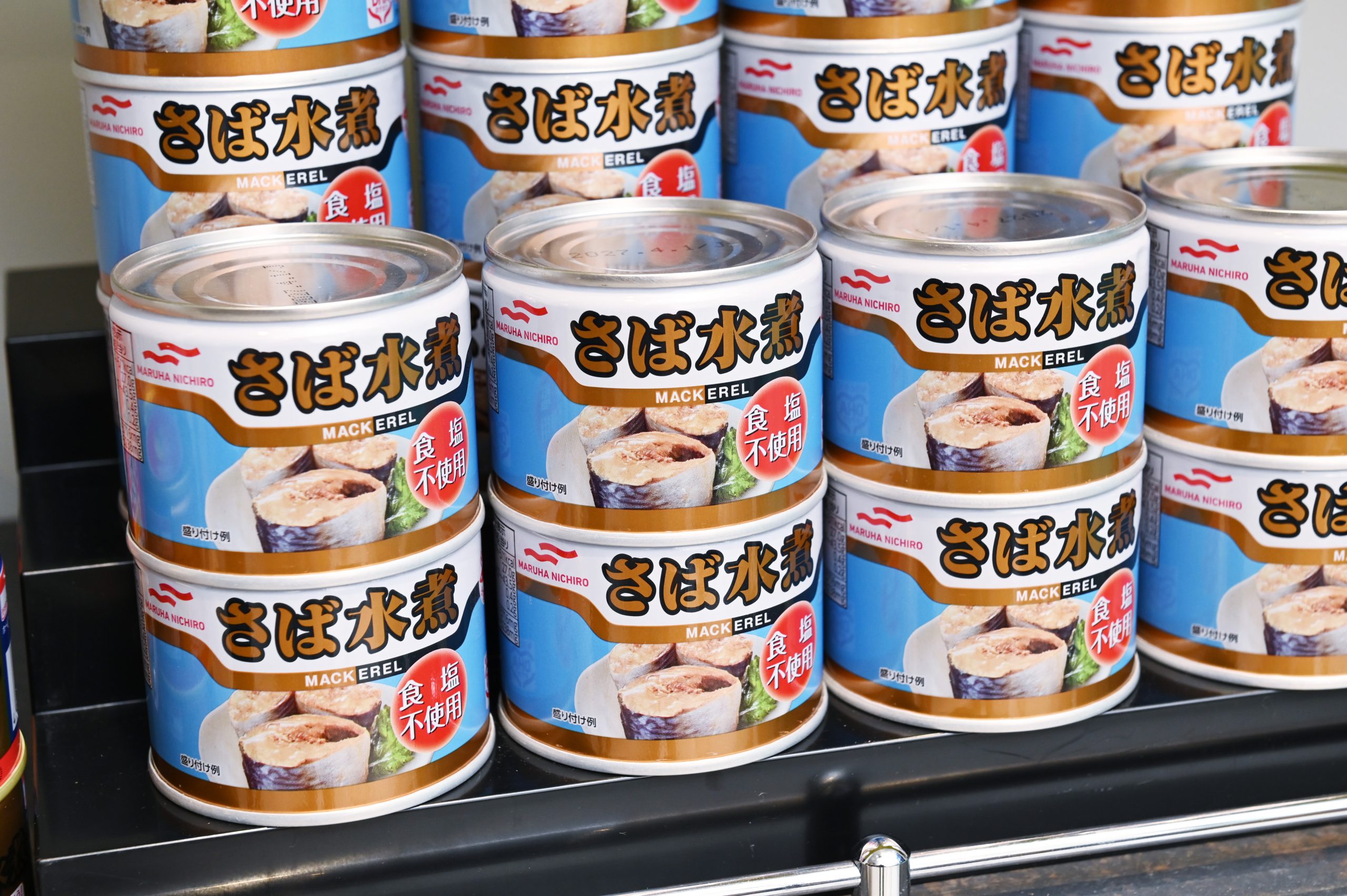
A salt-free type of canned mackerel boiled in water. It is popular for its original taste of mackerel.
--I think it is possible to create healthy value while maintaining the concept of "tasty food". On the other hand, there are resource management issues in the fisheries industry.
【Owada】 For example, Alaska has the world's largest share of Alaska pollock production, but in order to access the resource sustainably, it is necessary to protect the communities of the people who live there. We have been communicating and collaborating with the people who live there. This is also true in Micronesia, where skipjack fishing is thriving.
The same is true in Japan. Many of the people who work at the farms and factories are local people. Our products are made in cooperation with these people. We think it is important to let people know that. We thought that if we shared our products as content on a community website, participants would be more interested in the environment and resources. This is the aim of the "Work Introduction" content, which conveys not only the products but also the other side of the story.
【Noguchi】 Pollack is an ingredient of our frozen food "White Fish Tartar Sauce". Thanks to a distant community in Alaska, the catch becomes a side dish for lunch boxes in Japan, bringing smiles to children and their families. I think the best part of our community website is that we can tell the story of how we got there directly to our customers.
-Many companies work on both ESG and SDGs at a distance from the company's core business. If a consumer goods manufacturer suddenly announces one day that it is planting trees, customers will not understand the connection. Then, even if they wanted to support them, they would not be able to do so. On the other hand, Maruha Nichiro is making such efforts in close proximity to its core business. I think that is very right.
【Owada】 I believe that solving social issues can definitely be linked to economic value, depending on how it is done. I believe that "food and health" is right in the middle of the spectrum. That is why we have stated the creation of health value as one of the materialities in our current medium-term management plan, and we will continue to strengthen it in the future. Again, the important thing is not only to embody this in our products, but also to communicate it and share it with our customers.
--"Oishiine!" will co-create a variety of values such as health and environment with customers. "Oishiine!!"will continue to expand as an important point of contact and the core of such value creation, right? will continue to expand in the future? I have high expectations for its future activities.
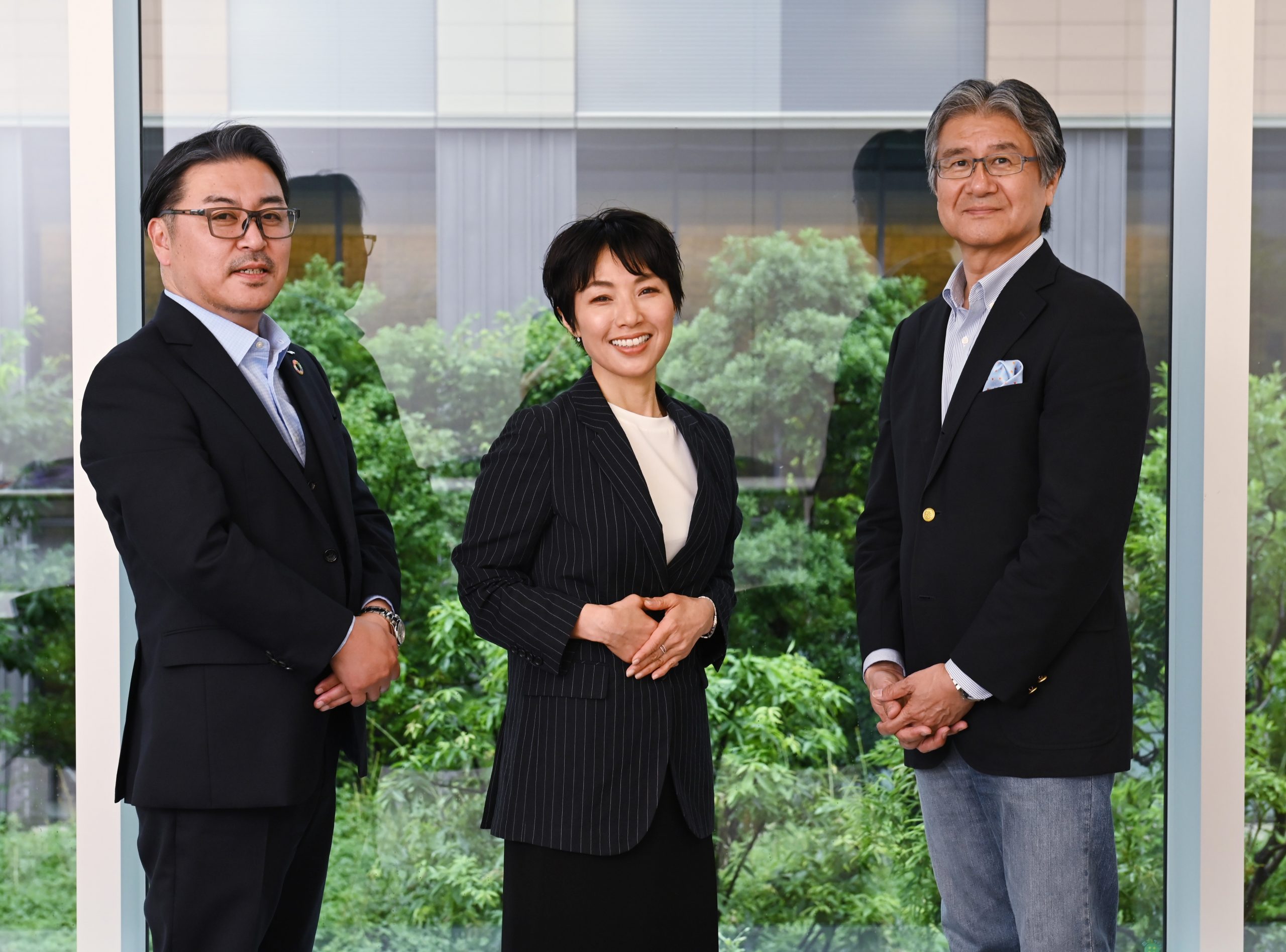 For the seventh installment of "visiting PRM practice companies," we visited Maruha Nichiro Corporation.
For the seventh installment of "visiting PRM practice companies," we visited Maruha Nichiro Corporation.eLife Inc. and Maruha Nichiro have had a relationship of more than 10 years in the form of support for corporate community management. However, over the past 10 years, the corporate environment and customer awareness have changed, and the way in which the community is managed and what the company and its customers want from the community have changed little by little.
One of the main purposes of a company's community engagement is to listen to the "voice" of the customer and discover insights that are difficult to uncover through conventional surveys. Equally important is to provide useful experiences for customers through dialogue with companies and brands. As a result, those who share our "passion" for corporate activities and product development become our core fans.
In addition to the two objectives I have just mentioned, it seems to me that Maruha Nichiro is also trying to solve social issues through the community. In recent years, against the backdrop of global environmental and resource issues and changes in corporate and individual values, there has been a growing awareness that for a company to grow sustainably, it must invest in non-financial factors, such as whether it is environmentally conscious, provides a safe working environment, and has established a system that does not tolerate fraud. this concept is called management. This concept is called ESG management, and it is noteworthy that Maruha Nichiro has extended the direction of ESG investment not only to corporate activities but also to online communities and local communities.
The first step is to scoop up local issues on the ground, think about what can be done there, and implement countermeasures in cooperation with the local community, using the findings and examples of other local communities as a guide for companies. Then, by sharing the current situation and issues with customers in the online community, companies and individuals can think about what they can do, make suggestions, and take action. We believe that this kind of linkage will achieve both social value and economic value. As a result, awareness of the global environment and conservation of marine resources will be raised from the "dining table," a page in our daily lives. I felt that this is a wonderful initiative. (Interviewer: Tatsuo Ishii)
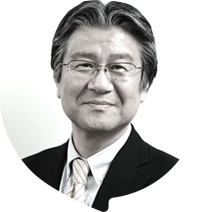 Tatsuo Ishii, Executive Advisor, eLife Inc. Tatsuo Ishii, Executive Advisor, eLife Inc.He served as manager of a number of brands for 14 years at Kao Corporation, where he also launched Agience as a new business. In 2003, he established the Digital Marketing Center, where he was involved in the planning and operation of web-based strategies and established the Digital Marketing Center as the head of the center. In 2017, he was appointed as Executive Advisor for eLife Inc.. He is a part-time lecturer at the Graduate School of Business Administration, Waseda University, a Marketing Meister of the Japan Marketing Association, a member of the Digital Media Committee of the Japan Advertisers Association, the Chairman of the Brand Experience Jury of the Dentsu Advertising Awards, and an auditor at C Channel K.K. He is a leading marketing expert. |
(Composition: Atsuo Suzuki)

